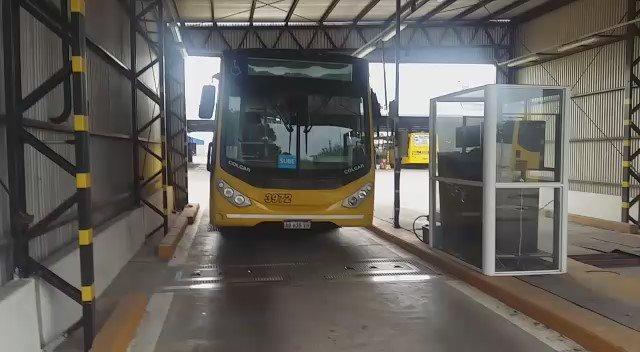Says Feldmann; “The key motivation for buying a piece of equipment like PNEUSCAN INGROUND was the need to optimise our tyre costs, one of the fleet’s key maintenance costs. We looked at other systems available on the market, but they all required the use of a separate device to measure the inflation pressure and the tread depth. PNEUSCAN measures these values simply by driving the vehicle over the surface.
“The main advantage for our organisation was to be able to work with an autonomous piece of equipment, which, with almost no human work input, can make critical measurements relating to the condition of the tyres with an acceptable level of accuracy. The elimination of human operation was a major benefit in terms of time saving, whilst reducing the need for control and the possibility of errors in the operation.”
The PNEUSCAN INGROUND system at Rosario Bus S.A. was installed in an outdoor location at the company’s head office location in the city of Rosario. Included in the installation were four key modules – the PNEUSCAN ATM tyre pressure measurement tool, the PNEUSCAN PRO tread depth measuring system, the PNEUSCAN RFID tyre data assignment tool, and the PNEUSCAN DAT data management system.
The PNEUSCAN system generates measurement values for every vehicle that crosses over the system. Besides the presentation on the systems‘ display this data is sent to the PNEUSCAN DAT data management tool for analysis at a later time. Integration into Rosario Bus’s own data structure is carried out via an XML-based interface.
According to Fernando Feldmann, prior to the installation of the PNEUSCAN INGROUND system, nearly 30% of the fleet’s tyres were outside the expected pressure range, whilst in the region of 5% of tyres were operating with critical levels of wear on the tread. A key aim of the installation of the system was to significantly improve these figures in order to improve safety and reliability, reduce fuel consumption, prevent breakdowns due to poor tyre conditions, optimise labour efficiency, and extend tyre life.
The module within the PNEUSCAN system used to measure and optimise tread pressures is the PNEUSCAN ATM, which gathers within seconds the foot prints of all rolling tyres, including twin tyres, while the vehicle is crossing over the sensor array. On the basis of this data, the tyre pressures are calculated. Information on the current tyre pressures are then shown at the built-in display. If necessary, a pressure correction of the according tyre can be arranged immediately. Due to the electronic documentation of the pressure values, this can be useful for long-term tyre management, such as the recognition of slow punctures.
Says Feldmann; “In November 2016, shortly after start-up, critical pressures were as high as 28.99% of the fleet, but this had reduced to 18.41% by March and now is running at only 4.59%, which is a massive difference.”
According to Feldmann, similar results have been achieved in the area of tread depth management, thanks to the PNEUSCAN PRO module which calculates the tyre´s tread depth by applying a laser plane intersection procedure. This method not only provides tread depth information but also information on possible axial misalignment. Meanwhile, the electronic documentation of the tread depth values can be useful for tyre management purposes. For example, based on the tread depth history of the tyres, the stockpiling and demand of different tyre models can be planned.
Says Feldmann; “In November 2016 as many as 5.06% of the fleet’s tyres were running on tyres with critical tread depth, but the implementation of the PNEUSCAN system had an immediate impact. The difference in the figures was noticeable from Month 1, and by July 2017, we had reduced this figure to 0.86%.”
It is now over a year since the PNEUSCAN INGROUND system was installed, but now Feldmann is looking at the long-term benefits of the system.
“In the first year of operation, the equipment has remained operational with little maintenance demand, and as a result we have able to reduce the direct cost of labour dedicated to the maintenance of tyres by as much as 70%, whilst continuing to guarantee a reliable tracking of the fleet. In the medium term, we hope to improve the mileage of our tyres by as much as 15-20%, as a result of maintaining the inflation pressure within an optimum range of operation. The time necessary to obtain the greatest benefit is estimated to be between 2 and 3 years.
“Return on investment is also impressive,” he adds. “Even if we were only to achieve a 5% improvement in the mileage of the tyres, the savings achieved, including those in maintenance personnel, mean we fully expect a recovery of our investment within two years.”
VENTECH Systems GmbH
Halterner Strasse 195
46284 Dorsten
Telefon: +49 (2362) 95224600
Telefax: +49 (2365) 91544-8
http://www.ventech.de
Marketing
Telefon: +49 (2362) 9522-4611
E-Mail: Anja.Reinert@ventech.de
![]()
